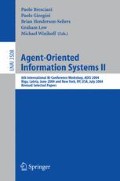Abstract
There is an inevitable need for collaboration and coordination among response organizations during the occurrences of emergencies. We attack the coordination problem by analyzing intelligent agents’ organizational behaviours and exploring a set of coordination mechanisms. This paper studies the application of our coordination research to a small-scale Emergency Medical Services (EMS) information system with response agencies modeled as organizations of autonomous agents. Due to the excessive amount of information and the dynamic change in the environment, the information decision process has become the backbone of EMS. The significance of our extended set of GPGP coordination mechanisms is examined under various environmental settings in this application domain. This paper models the coordination among three organizations during emergency responses to a set of small scale, concurrent incidents, like ambulance calls, police calls and mixed calls with potential needs of transporting the emergency victims to appropriate medical facilities. An EMS agent framework is implemented, an integrated coordination algorithm is introduced, early experimental results are presented and finally appropriate decisions are suggested for the response organizations. This paper also briefly discusses the extension for the management of emergency incidents to larger scale disasters.
Access this chapter
Tax calculation will be finalised at checkout
Purchases are for personal use only
Preview
Unable to display preview. Download preview PDF.
References
Decker, K., Li, J.: Coordinating mutually exclusive resources using GPGP. Autonomous Agents and Multi-Agent Systems 3, 133–157 (2000)
Chen, W.: Designing an Extended Set of Coordination Mechanisms for Multiagent Systems. PhD thesis, Computer and Information Sciences, University of Delaware (2005)
Chen, W., Decker, K.: Applying coordination mechanisms for dependency relationships under various environments. In: Proceedings of Workshop in AAMAS 2002: MAS Problem Spaces and Their Implications, Bologna, Italy (2002)
Sachs, G.M.: Officer’s Guide to Fire Service EMS. Fire Engineering (1999)
Clark, T., Waring, C.: A simulation approach to analysis of emergency services and trauma center management. In: The 1987 Winter Simulation Conference (1987)
Iskander, W.H.: Simulation modeling for emergency medical service systems. In: Proceedings of the 1989 Winter Simulation Conference (1989)
Parker, W., Johnson, R.: Simulation of a coordinated accident rescue system. In: The fourth annual conference on Applications of simulation (1970)
Christie, M., Levary, R.: The use of simulation in planning the transportation of patients to hospitals following a disaster. Journal of Medical Systems 22, 289–300 (1998)
Wears, R., Winton, C.: Simulation modeling of prehospital trauma care. In: The 1993 Winter Simulation Conference (1993)
Giiler, N., Ubeyli, E.: Theory and applications of telemedicine. Journal of Medical Systems 26, 199–220 (2002)
Nagatuma, H.: Developing of an emergency medical video multiplexing transport system. Journal of Medical Systems 27, 133–140 (2003)
Carley, K., Gasser, L.: Computational organization theory. In: Multiagent Systems: A Modern Approach to Distributed Artificial Intelligence. MIT Press, Cambridge (1999)
Malone, T., Crowston, K.: The interdisciplinary study of coordination. ACM Computing Surveys, 87–119 (1994)
Garvey, A., Humphrey, M., Lesser, V.: Task interdependencies in design-to-time real-time scheduling. In: AAAI 1993, pp. 580–585 (1993)
Decker, K.S.: TÆMS: A framework for environment centered analysis and design of coordination mechanisms. In: O’Hare, G., Jennings, N. (eds.) Foundations of Distributed Artificial Intelligence. Wiley Inter-Science, Chichester (1996)
Udupi, Y., Yolum, P., Singh, M.: Trustworthy service caching: Cooperative search in p2p information systems. In: Giorgini, P., Henderson-Sellers, B., Winikoff, M. (eds.) AOIS 2003. LNCS, vol. 3030, pp. 32–44. Springer, Heidelberg (2004)
Chen, W., Decker, K.: Managing multi-agent coordination, planning, and scheduling. In: Proceedings of the Third Autonomous Agent and Multi-Agent Systems, New York, USA (2004)
Erol, K., Hendler, J., Nau, D.: HTN planning: Complexity and expressivity. In: AAAI 1994, pp. 1123–1128 (1994)
Graham, J., Decker, K., Mersic, M.: DECAF a flexible multi-agent system architecture. Autonomous Agents and Multi-Agent Systems 7, 7–27 (2003)
Bureau of Labor Statistics: Occupational outlook handbook, 2002-2003 edition (2003), http://www.bls.gov/oco/
Durfee, E.: Scaling up agent coordination strategies. IEEE Computer 34, 39–46 (2001)
Quinlan, R.: Improved use of continuous attributes in c4.5. Journal of Artificial Intelligent Research 4, 77–90 (1996)
Author information
Authors and Affiliations
Editor information
Editors and Affiliations
Rights and permissions
Copyright information
© 2005 Springer-Verlag Berlin Heidelberg
About this paper
Cite this paper
Chen, W., Decker, K.S. (2005). The Analysis of Coordination in an Information System Application – Emergency Medical Services. In: Bresciani, P., Giorgini, P., Henderson-Sellers, B., Low, G., Winikoff, M. (eds) Agent-Oriented Information Systems II. AOIS 2004. Lecture Notes in Computer Science(), vol 3508. Springer, Berlin, Heidelberg. https://doi.org/10.1007/11426714_3
Download citation
DOI: https://doi.org/10.1007/11426714_3
Publisher Name: Springer, Berlin, Heidelberg
Print ISBN: 978-3-540-25911-4
Online ISBN: 978-3-540-31946-7
eBook Packages: Computer ScienceComputer Science (R0)

